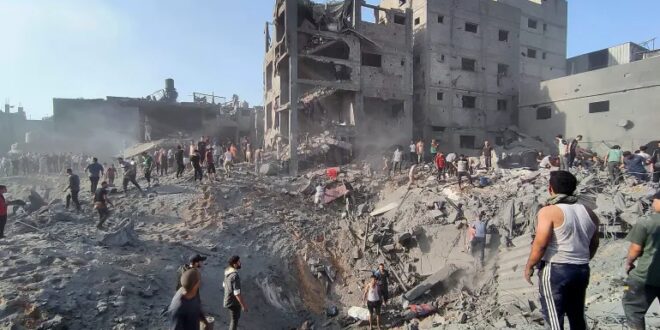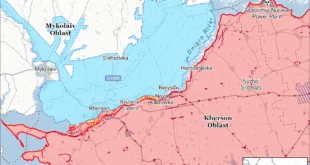A back of the envelope calculation suggests it has already cost Israel more than $2bn with little actual gains to show for it.
The first response by Israel to the Hamas attacks of October 7 was to send in the air force to bomb Gaza. The air force was given a long list of potential targets, related to the attacks or not. The logic was to show to Israelis and Palestinians alike that Israel was not down but could muster a quick, resolute and brutal response.
Israel initially released reports of the number of air strikes it was conducting, but probably realising that admitting having bombed Gaza thousands of times was bad public relations, it switched instead to reporting the number of “targets” it was hitting. The last figure was released about a week ago claiming 12,000 targets attacked. Without the specifics of how they were hit and with what means, the number doesn’t say much.
But a lot can be deduced from the total number of bombs used. This week, Palestinian officials reported that 18,000 tonnes of bombs have been dropped on Gaza. The destruction on the ground is consistent with this figure.
Almost all bombs dropped belong to the United States-designed Mk80 family, which has been in service since the Vietnam War. Originally designed as conventional free-fall weapons or “dumb bombs”, they have been constantly modernised with sophisticated targeting devices that have converted them into “smart bombs”. These bombs are made in various sizes, classified by total weight of the weapon: 120kg (265lb), 250kg (551lb), 500kg (1,102lb)and 1,000kg (2,204lb).
The Israeli air force uses three main types of fixed-wing aircraft, all US-made. The F-15 fighter jet’s main role is to secure aerial superiority although some also can be used as bombers. Israel ordered 75 of the latest F-35 fighter-bombers and has received about 40 so far. These jets are probably not being used to bomb Gaza, but they patrol the skies against any threats. This week, a video was released of an F-35 shooting down a Houthi cruise missile launched at Israel from Yemen.
The workhorse of the Gaza bombing campaign is the F-16, an old and proven aeroplane. Israel built a modified version of the fighter jet to suit its tactics with a second crew member whose main task is to control precision weapons. About 100 are in service. Although each can carry 7 tonnes, for practical purposes, it can be assumed that every F-16 takes off with four bombs.
If all of the four bombs were 1,000kg versions, 4,500 flights would be required to deliver 18,000 tonnes of bombs. But not all bombs used are of the heaviest type, so the number of bombing flights over Gaza might be closer to 6,000.
The air force has about 170 F-16s of all versions. In any air force, about 20 percent of aircraft are at any time out of service for regular maintenance, upgrades or repairs. Israel is known for professional and speedy support, so about 150 F-16s probably are usable at any time. As the campaign continues, this number will start to decrease as continuous use will require additional maintenance and replacement of parts that get worn out. But that will happen gradually, and Israel will be able to keep more than 100 F-16s in flying condition at any time.
Thus F-16s apparently fly an average of 1.5 combat missions per day. Given the specifics of the battlefield with no fewer than seven Israeli airbases within a 50km to 100km (31- to 62-mile) range from Gaza, flight times are short, so pilots can sustain flying at the current rate without worrying about long-term fatigue setting in. All air forces try to have at least two, preferably three, crews per aircraft. Although exact numbers are always one of the most guarded secrets, the Israeli air force has enough active pilots and reservists with updated training to keep regular rotations.
While Israel does not need to worry about a possible shortage of soldiers for the aerial battles, it might have to consider the logistics and finances of the bombing campaign.
Six hundred tonnes of bombs per day is a considerable amount: About 30 articulated lorries are needed just to transport them. Costs are also mounting: a 1,000kg bomb costs the US air force a reported $16,000. A much smaller foreign customer like Israel would probably have to pay a higher price of $25,000 per tonne just for the dumb version without the cost of adding the sophisticated and often much more expensive targeting electronics and hardware.
That makes for a daily price tag of well over $15m just for the basic bomb. With the add-ons, it’s fair to assume that the figure rises to at least $25m per day. At that rate, the bombing campaign has so far cost Israel a minimum of $750m just in bombs.
What about additional costs? The F-16 is claimed to have a “very low” cost in flight, “only” $8,000 per hour. Assuming a minimum of 300 flight hours per day gives a figure of $2.5m per day, or $75m so far.
Adding to the calculation all additional aerial assets needed to sustain the bombing like surveillance, reconnaissance, electronic warfare, airborne early warning, command and control, and the like, the cost of the entire aerial campaign skyrockets.
Israel has probably spent at least $2bn so far to bomb Gaza, and the figure could be even higher. This is without the cost of mobilizing and keeping under arms 360,000 reservists and waging the ground war that Israel began last week.
All that for very dubious military value. It is obvious that at the receiving ends of Israeli bombs are predominantly civilians and civilian infrastructure. There is little reason to believe that the figure of more than 9,000 people killed in Gaza, among which nearly 4,000 are children, includes more than a few hundred Hamas fighters.
Battles are won by men; wars are won by resources, according to an old military adage. But as the war drags on with little clarity by way of results from the Israeli perspective, Israel’s leaders will also be fighting this war with a calculator in their hands.
 Eurasia Press & News
Eurasia Press & News




